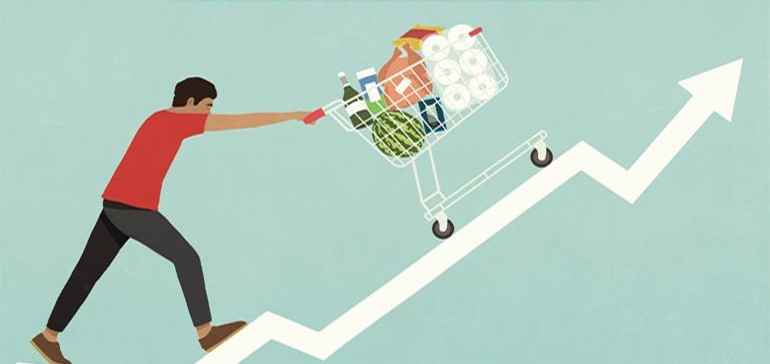
When there is an increased supply of money in the economy, people tend to spend that money more, which results in greater demand for goods and services. If the supply of goods and services remain constant, but the money supply increases and so does the demand for goods and services, the average price of those goods and services increases in response. This is the most basic explanation of inflation.
The link between money and inflation is that the former can cause the latter if there is no real change in economic output. In other words, if the money in circulation increases but the production of goods and services does not increase proportionally but remains constant, then sellers must increase prices. As Milton Friedman explained it with such simplicity, “Inflation is caused by too much money chasing after too few goods.” In the case of inflation, more money equals more problems!
Economists say that with the increase of the supply of money there appears an increase in aggregate demand which results in higher prices.
Here are some examples from history of increased money supply causing inflation:
- US Confederacy 1862-65 In the USA, there was a civil war between the north and the south about several issues, including slavery. The southern states required slaves for economic reasons, since they were a primarily agricultural-oriented society, with cotton being a major crop for production. The southern states set up their own country known as Confederate States of America (CSA), which was not recognized by Great Britain but was granted a neutral status which later the British withdrew for their own reasons of not encouraging the working-class rebelling in the United Kingdom. During this internal war between the southern states and the northern states, the former found itself short of finance (the CSA only managed to raise approximately half of the cost of war around 46% from taxes and bonds) so they printed more money to pay for materials and soldiers in war. The problem was that the economic reality did not reflect the surge in the printing of money; real economic output was falling, but the money printed was surging, resulting in inflation of 700% in the first two years of the war and reached a peak of more than 5000% by the end of the war.
- German Hyperinflation 1923 When Germany was forced to pay reparations after WW1, it was having economic problems. As a result, the government engaged in printing money, in fact too much money. When Germany reached the important year of 1923, the economy had reached the critical phase of hyperinflation.
- Zimbabwe 2008 Recently, the African nation of Zimbabwe experienced hyperinflation. When the government debt reached high levels, economic output declined, the nation adopted the German strategy of printing more money to reduce the crisis. This printing of money led to hyperinflation of an estimated 79,600,000,000% in Nov 2008. A daily inflation rate of 98%
- US economy 2020/21 When Covid-19 pandemic struck in 2020, the US economy declined enormously. This meant the Federal Reserve had to create more money. In 1-2years inflation struck hard (this inflation was also caused by other factors such as commodity price rises and supply chain disruptions).
It is important to note that increasing the money supply does not always cause inflation.
It is possible to increase the money supply without causing inflation. There are a few possible reasons:
- The growth of real output is the same as the growth of the money supply. If we imagine that the supply of money increased by 10 %. This would lead to an increase of Aggregate Demand by the same percentage in a simplified model. And if the productive capacity of the economy also increased by 10% then the price level would be unaffected. In other words, the growth of the money supply is absorbed in the increase in real output.
- Increase in bank reserve ratios. The Federal Reserve increased the monetary base by over 120%; however, this did not result in inflation, in fact, the US experienced temporary deflation. The main reason is that banks increased their reserve ratio. Essentially banks received extra money from the Federal Reserve but did not want to lend it to ordinary firms and households. Therefore, the extra money supply did not reach the wider economy and there was no inflationary impact.
- Hard to Measure Money Supply. Sometimes the money supply is hard to calculate and is constantly changing. Large increases in the money supply are often just due to changes in the way people hold money. For example, an increase in credit card use may cause an increase in the broad money supply M4.
- Changes in velocity of Circulation. The quantity theory of money equation MV=PY assumes that an increase in M causes an increase in P. However, this assumes that V (velocity of circulation) is constant, and Y is constant. However, in practice, it is not as simple as this equation assumes. There are often variations in the velocity of circulation. A good example is in a recession, the stock of money may rise 5%, however, people will be making fewer transactions and therefore the velocity of circulation will fall. This is one reason why quantitative easing (increasing the money supply) did not cause inflation between 2009 and 2016.
- Keynesian view – Liquidity Trap In a recession, there is spare capacity in the economy. Therefore, an increase in the money supply merely helps to get unemployed resources used in the general economy. Therefore, in the case of a recession, an increased money supply is unlikely to cause inflation. In a liquidity trap, interest rates fall to zero, but this doesn’t prevent people from saving. In this situation, there is a fall in the velocity of circulation, and this can cause deflation. In this situation, increasing the money supply will not necessarily cause inflation.
Relevant News & Blogs

When one job is not enough: The pathway to multiple careers
An average career span lasts 40 years. But humans are living longer and the idea of work years...
More
After Bill Gates, CEO Of Nokia To Also Visit Pakistan With Investment Potential
Caretaker Federal Minister for IT and Telecommunications, Dr. Umar Saif, has disclosed an...
More
Are you an extrovert? These 6 career paths might bring out the best in you
Before committing to a specific career path, it’s important to ensure that it aligns well...
More
10 Tips for Improving Your Public Speaking Skills
Few are immune to the fear of public speaking. Marjorie North offers 10 tips for speakers to...
More
5G Launch Is Nearly Impossible In Next 10 Months In Pakistan
Islamabad: The launch of the 5G spectrum in Pakistan in 10 months is nearly impossible....
More
6 ways to boost your confidence in the workplace
Everyone is aware of the importance of competence for success at the workplace, in...
More